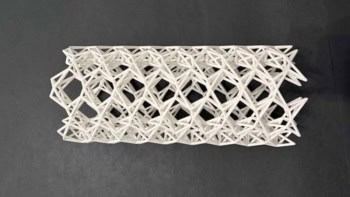
A new metamaterial film provides cooling without needing a power input. Made out of glass microspheres, polymer and silver, the material uses passive radiative cooling to dissipate heat from the object it covers. It emits the energy as infrared radiation and also reflects solar light. A team at the University of Colorado Boulder (CU-Boulder) in the US developed the material after receiving a $3m federal grant from the US Department of Energy’s Advanced Research Projects Agency-Energy (ARPA-E) in 2015.
Radiative cooling is the natural process through which objects shed heat in the form of infrared radiation. All materials at room temperature emit infrared at wavelengths of 5–15 μm. However, the process is not typically very efficient because it is counteracted by external influences that heat the object, such as sunlight and air currents. Air, meanwhile, absorbs and emits very little radiation with wavelengths 8–13 μm. The Earth cools itself at night by emitting infrared through this “atmospheric window” and into space.
Researchers are therefore interested in engineered materials that can enhance this natural process and cause objects to efficiently emit infrared through the atmospheric window. In theory, such materials could provide a simple way of cooling buildings and heat-generating technologies without the need for power-hungry machines.
Daytime challenge
While night-time radiative cooling materials, including a pigment paint, have been successfully developed, a daytime version has proved challenging. The problem is that the materials absorb sunlight, which quickly exceeds the cooling power and instead heats the surface.
So the challenge for the CU-Boulder researchers was to create a material that both reflects sunlight and also allows infrared emission. They created a thin, flexible material with two layers; a sheet of polymer polymethylpentene containing randomly dispersed silicon-dioxide (SiO2) glass microspheres 8 μm in diameter and a 200 nm-thick silver coating. The combination of the two layers is only 50 μm thick.
Magic film
“The randomized glass-polymer film is the one doing the magic,” explains Ronggui Yang, an author on the paper. The polymer-microsphere film is transparent to the whole solar spectrum but radiates infrared. The broad collective resonance among the microspheres ensures the film is highly emissive of infrared within the atmospheric range of 8–13 μm. This property therefore enhances the naturally occurring radiative cooling. Meanwhile, sunlight travels through the metamaterial and is reflected back by the silver coating, which prevents any solar heating.
The randomized glass-polymer film is the one doing the magic
Ronggui Yang, University of Colorado Boulder
But it is not just the properties of the material that the CU-Boulder group reports in Science. “The key innovation of this work is to produce the designed material at scale using the roll-to-roll process,” explains Yang. The researchers used a roll-to-roll extruder to distribute the microspheres in the polymer and a roll-to-roll sputtering machine to apply the silver coating. This means they are able to produce large amounts of the material in mere minutes. “When produced at scale, we estimate that the material cost is only $0.50 per m2 (yes, 50 cents per square metre), since it can be produced at 100 square metres per minute,” adds Yang.
Midday Sun
Field tests in Boulder, Colorado and Cave Creek, Arizona, revealed that the film’s average cooling power was more than 110 W/m2 over 72 hours. Even in the midday Sun, its average was 93 W/m2. This is roughly equivalent to the electricity generated by a typical solar panel of the same area.
The new material is similar to one produced by a group at Stanford University in 2014, which emitted roughly 40 W/m2 in direct sunlight. The previous design was fabricated using electron evaporation and consisted of seven alternate layers of silicon dioxide and hafnium dioxide. Not only does the new material appear to outperform the old (although testing methods are not directly comparable), it is also easier to make in large quantities.
The glass-polymer sheet has many potential cooling applications. By applying it to a solar-panel’s surface, the film could not only cool the panel but also recover an additional one or two per cent of solar efficiency, because overheating hampers the ability to convert solar energy. “That makes a big difference at scale,” says Xiaobo Yin, another researcher on the project.
But applying the film to buildings is not as simple as putting a layer on the roof. “You cannot just use our material to wrap a building,” explains Yang. This would cool the building in hot summers, but it would also continue cooling on cold nights and during the winter. The team therefore needs to create a thermal system design whereby water is cooled then circulated around the building. This is similar to a hot-water heating system and means the temperature can be controlled.
Works 24/7
“The key advantage of this technology is that it works 24/7 with no electricity or water usage,” says Yang. “We’re excited about the opportunity to explore potential uses in the power industry, aerospace, agriculture and more.”
The next step for the researchers is to create a 200 m2 “cooling-farm” prototype in Boulder. They have also applied for a patent and are working with CU-Boulder’s Technology Transfer Office to explore commercial applications.



